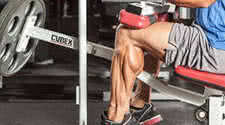Calves Muscle Exercise Guide: Outer Calf Muscle Development Workout

With Consistency and Dedication you'll Achieve your Goals
A common question regarding calf training, is how do you develop the outer head of the gastrocnemius calf muscle? Do you
point your toes out and in while doing calf raises.. will that help to develop that nice diamond shape? Is there a best
exercise for the outer head, or a secret method of developing that area?
I definitely feel that development of the outer calf is related to genetics, to a certain degree. After all, some people
are blessed with beautiful, full, diamond-shaped calves, but they've never trained a day in their lives. Others have to
struggle to add any size or development to their calves. No matter how hard they train or how long they train, the muscle
cells are just not there to be developed. Many people are cursed with high "sprinter" calves, a small ball of muscle right
below the knee, rather than calves that tie in near the ankle as those who are blessed with long, full calves - Vince
Taylor, Chris Dickerson or Mike Matarazzo, for example.
That doesn't mean you shouldn't try to develop the area. Some people can develop very good calves - both inside and
outside heads - with hard work and you may be one of them. To target the outside head of the gastrocnemius use a wide
stance (shoulder width) for standing calf raises, donkey calf raises, and toe presses on the leg-press or hack-squat machine.
This forces you to "roll" on the outside edge of the foot, which puts pressure on the outside head in the fully contracted
top position. You can also use a wide stance when doing seated calf raises, which helps to develop the outer soleus muscle.
There are alterative ways. John Parrillo uses a different method with his athletes. John recommends twisting the heels out
forcibly at the top of calf raises to work the outer head. Consciously try to put pressure on the big toe of each foot as
you twist the heels out to maximize the effect. Locking your knees at the top of the movement will emphasize more
gastrocnemius contraction. No matter which calf exercise you do, or whether you employ the Parrillo heel twist or the
wide-stance method, make sure you employ proper exercise form. This means lowering your heels as low as possible - until
you feel an extreme stretch - before starting up. Do not just bounce up and down using partial reps (save those for the end
of the set after you've done as many full reps as possible). Drive the heels down forcibly and then explode up as high as
you can.
Try to get the most extreme stretch and the most intense contraction on each and every rep. This means the largest range
of motion possible. It's more painful. And there's nothing like calf pain to make you realize the discomfort of a good
muscle pump. Occasionally try doing a combination of heavy low-rep lifting (10 reps) and lighter high-rep sets (15 to 25
reps). Then every couple of workouts, shock the calves with some real high-rep sets of 50 to 100 reps. That is brutally
hard work, but it does blitz the calves like nothing else can. Supersets may also be effective. Try super setting-standing
calf raises with donkey calf raises for 4 sets of 15 to 25 reps. Stretching between sets can also greatly enhance calf-training.
Do the negative-only portion of standing calf raises one leg at a time. Hold at the bottom for a count of 10 to 15 seconds.
Do this as part of your rest between sets or supersets.
Most of all, be persistent. Don't give up. Calf improvement often takes more time than other bodyparts, but with steady,
intense training your calves will slowly but surely improve in size and shape. Good luck.